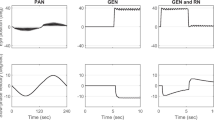Abstract
To review our studies and “top-down” models of saccadic intrusions and infantile nystagmus syndrome with the aim of hypothesizing areas of cerebellar connections controlling parts of the ocular motor subsystems involved in both types of function and dysfunction. The methods of eye-movement recording and modeling are described in detail in the cited references. Saccadic intrusions, such as square-wave jerks and square-wave oscillations, can be simulated by a single malfunction, whereas staircase saccadic intrusions required two independent malfunctions. The major infantile nystagmus syndrome waveforms are traceable to a failure to calibrate the damping ratio of the smooth pursuit system. The use of a behavioral ocular motor system model demonstrated how putative cerebellar dysfunctions could accurately simulate both the oscillations and the ocular motor responses seen in patients with both saccadic and pursuit disorders.






Similar content being viewed by others
References
Robinson DA. How the oculomotor system repairs itself. Investig Ophthalmol. 1975;14:413.
Young LR, Stark L. A discrete model for eye tracking movements. IEEE Trans Military Elect MIL. 1963;7:13–115.
Robinson DA. Models of oculomotor neural organization. In: Bach-y-Rita P, Collins CC, Hyde JE, editors. The control of eye movements. New York: Academic; 1971. p. 519–38.
Robinson DA. Models of saccadic eye movement control systems. Kybernetik. 1973;14:71–83.
Cannon SC, Robinson DA. Loss of the neural integrator of the oculomotor system from brain stem lesions in monkey. J Neurophysiol. 1987;57:1383–409.
Dell’osso LF. A dual-mode model for the normal eye tracking system and the system with nystagmus (PhD dissertation). Laramie: University of Wyoming; 1968. p. 1–131.
CEMAS_Working_Group. A National Eye Institute sponsored workshop and publication on the Classification of Eye Movement Abnormalities and Strabismus (CEMAS). In The National Eye Institute publications. 2001. nei.nih.gov-sites-default-files-nei-pdfs-cemas. Accessed 30 Dec 2018.
Abel LA, Dell'Osso LF, Daroff RB. Analog model for gaze-evoked nystagmus. IEEE Trans Biomed Eng. 1978;BME-25:71–5.
Abel LA, Dell'Osso LF, Schmidt D, Daroff RB. Myasthenia gravis: analogue computer model. Exp Neurol. 1980;68:378–89.
Dell'Osso LF, Ayyar DR, Daroff RB, Abel LA. Edrophonium test in Eaton-Lambert syndrome: quantitative oculography. Neurology. 1983;33:1157–63.
Rucker JC, Dell'Osso LF, Jacobs JB, Serra A. “Staircase” saccadic intrusions plus transient yoking and neural integrator failure associated with cerebellar hypoplasia: a model simulation. Semin Ophthalmol. 2006;21:229–43.
Dell'Osso LF, Gauthier G, Liberman G, Stark L. Eye movement recordings as a diagnostic tool in a case of congenital nystagmus. Am J Optom Arch Am Acad Optom. 1972;49:3–13.
Dell'Osso LF. Fixation characteristics in hereditary congenital nystagmus. Am J Optom Arch Am Acad Optom. 1973;50:85–90.
Dell'Osso LF, Flynn JT, Daroff RB. Hereditary congenital nystagmus: an intrafamilial study. Arch Ophthalmol. 1974;92:366–74.
Dell'Osso LF, Daroff RB. Congenital nystagmus waveforms and foveation strategy. Doc Ophthalmol. 1975;39:155–82.
Dell'Osso LF, Flynn JT. Congenital nystagmus surgery: a quantitative evaluation of the effects. Arch Ophthalmol. 1979;97:462–9.
Dell'Osso LF. Congenital, latent and manifest latent nystagmus—similarities, differences and relation to strabismus. Jpn J Ophthalmol. 1985;29:351–68.
Dell'Osso LF. Evaluation of smooth pursuit in the presence of congenital nystagmus. Neuro-Ophthalmology. 1986;6:383–406.
Dell'Osso LF, Van der Steen J, Steinman RM, Collewijn H. Foveation dynamics in congenital nystagmus I: fixation. Doc Ophthalmol. 1992;79:1–23.
Dell'Osso LF, Van der Steen J, Steinman RM, Collewijn H. Foveation dynamics in congenital nystagmus II: smooth pursuit. Doc Ophthalmol. 1992;79:25–49.
Dell'Osso LF, Van der Steen J, Steinman RM, Collewijn H. Foveation dynamics in congenital nystagmus. III: vestibulo-ocular reflex. Doc Ophthalmol. 1992;79:51–70.
Dell'Osso LF, Williams RW, Jacobs JB, Erchul DM. The congenital and see-saw nystagmus in the prototypical achiasma of canines: comparison to the human achiasmatic prototype. Vis Res. 1998;38:1629–41.
Dell'Osso LF, Hertle RW, Williams RW, Jacobs JB. A new surgery for congenital nystagmus: effects of tenotomy on an achiasmatic canine and the role of extraocular proprioception. J AAPOS. 1999;3:166–82.
Dell'Osso LF. Nystagmus therapies: types, sites, and measures. OMLAB Report. 2005;111905:1–4.
Dell'Osso LF. Original ocular motor analysis of the first human with achiasma: documentation of work done in 1994. OMLAB Report. 2006;090506:1–21.
Dell’Osso LF, Wang Z, Leigh RJ, Jacobs JB. Hypothetical explanation for the role of proprioception in the damping of infantile nystagmus by tenotomy surgery: the small-signal gain hypothesis. In: Callaos N, editors. Proceedings of the WMSCI 2006 Conference. Orlando, FL; 2006. pp. 39–44.
Dell'Osso LF, Hertle RW, Leigh RJ, Jacobs JB, King S, Yaniglos S. Effects of topical brinzolamide on infantile nystagmus syndrome waveforms: eye drops for nystagmus. J Neuroophthalmol. 2011;31:228–33.
Dell'Osso LF, Jacobs JB. Normal pursiut-system limitations—first discovered in infantile nystagmus syndrome. J Eye Mov Res. 2013;6:1–24.
Dell'Osso LF. Nystagmus basics. Normal models that simulate dysfunction. In: Hung GK, Ciuffreda KJ, editors. Models of the visual system. New York: Kluwer Academic/Plenum Publishers; 2002. p. 711–39.
Jacobs JB, Dell'Osso LF. Congenital nystagmus: hypothesis for its genesis and complex waveforms within a behavioral ocular motor system model. JOV. 2004;4:604–25.
Wang ZI, Dell'Osso LF. A unifying model-based hypothesis for the diverse waveforms of infantile nystagmus syndrome. J Eye Mov Res. 2011;4:1–18.
Dell'Osso LF. A hypothetical fixation system capable of extending foveation in congenital nystagmus. J Neuroophthalmol. 2002;22:185–6.
Wang ZI, Dell'Osso LF. Being “slow to see” is a dynamic visual function consequence of infantile nystagmus syndrome: model predictions and patient data identify stimulus timing as its cause. Vis Res. 2007;47:1550–60.
Tusa RJ, Hove MT. Ocular and oculomotor signs in Joubert syndrome. J Child Neurol. 1999;14:621–7.
Leigh RJ, Zee DS. The neurology of eye movements. In: Contemporary neurology series. edition 3 ed. New York: Oxford University Press; 1999.
Yachnis AT, Rorke LB. Neuropathology of Joubert syndrome. J Child Neurol. 1999;14:655–72.
Author information
Authors and Affiliations
Corresponding author
Ethics declarations
Conflicts of Interest
The authors declare that there is no conflict of interest.
Additional information
Publisher’s Note
Springer Nature remains neutral with regard to jurisdictional claims in published maps and institutional affiliations.
This work was supported in part by the Office of Research and Development, Medical Research Service, Department of Veterans Affairs.
Rights and permissions
About this article
Cite this article
Dell’Osso, L.F. Ocular Motor System Control Models and the Cerebellum: Hypothetical Mechanisms. Cerebellum 18, 605–614 (2019). https://doi.org/10.1007/s12311-018-1001-y
Published:
Issue Date:
DOI: https://doi.org/10.1007/s12311-018-1001-y




